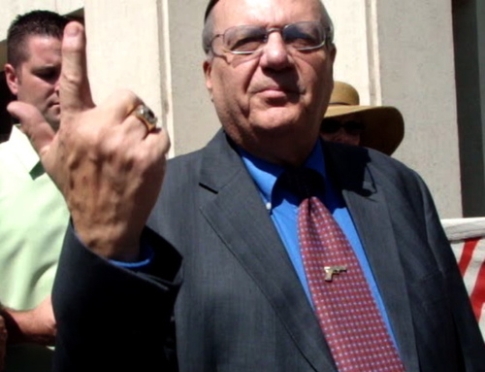The July 20th issue of The New Yorker paints a detailed portrait of Maricopa County, Arizona’s Sheriff Joe Arpaio—and it is not a pretty picture. The profile of “Sheriff Joe” that emerges from the story by journalist William Finnegan is that of a man obsessed with publicity and self-promotion, who has a deep streak of sadism and little regard for the U.S. Constitution, civil rights, actual crime-fighting, or protecting the safety of the public he ostensibly serves. While Arpaio persists in his personal crusade against unauthorized immigrants, serious crimes go unsolved, emergency-response times climb, and the rights of native-born Americans and immigrants alike are routinely trampled in the process. The most remarkable aspect of this story is that Arpaio is still legally permitted to carry a badge and a gun after more than a decade and a half of egregiously abusing his power.
Arpaio’s camera-ready histrionics have garnered the most attention; from attaching a neon “vacancy” sign to a guard tower in his “Tent City” prison camp in Phoenix, to parading unauthorized immigrants in chains through the streets. But, as Finnegan points out, there is also a dark and sometimes deadly underside to Arpaio’s reign. According to Finnegan, Maricopa County taxpayers have shelled out roughly $43 million so far to deal with the numerous lawsuits brought against Arpaio’s department for brutality. In an especially horrendous instance, Finnegan writes that a multi-million dollar pre-trial settlement was reached with the family of a prisoner murdered by Arpaio’s jail guards “after the discovery of a surveillance video that showed fourteen guards beating, shocking, and suffocating the prisoner, and after the sheriff’s office was accused of discarding evidence, including the crushed larynx of the deceased.”
Arpaio is none too shy about releasing his deputies upon public critics of his department as well. Finnegan says that, when the Phoenix New Times investigated Arpaio’s real-estate dealings, two executives of the paper’s parent company found themselves subject to late-night raids and arrest at their homes. Finnegan also notes that, “last December, remarks critical of Arpaio were offered during the public-comment period at a board of supervisors meeting, and four members of the audience were arrested and charged with disorderly conduct—for clapping.” In another instance recounted by Finnegan, when Arpaio heard that he was the subject of disparaging remarks made by the wife of Mesa’s mayor, he told his deputies “we gotta raid Mesa again”—referring to the military-style street sweeps he utilizes to randomly round up dark-hued people and ferret out the unauthorized immigrants among them.
Arpaio’s fact-free and publicity-hungry approach to the immigration issue was perhaps best captured in Finnegan’s account of the sheriff’s excitement upon hearing early reports that the H1N1 swine flu outbreak had originated in Mexico. He urgently wanted to get out a press release and suggested a headline of “Illegal Immigration Breeds Crime, Disease.” He asked his staff about the possibility of securing surgical masks for guards in the Tent City complex. When a public-health specialist who was present dared to point out that “surgical masks do nothing to combat this virus,” Arpaio yelled, “This is my press release! I’m the sheriff! I have some knowledge!” In the end, the headline of his press release read: “Arpaio Says Swine Flu Underscores Need for Illegal Immigration Enforcement: Will Supply Deputies with Protective Gear for Arrests of Illegal Immigrants.”
The abuses, excesses, and crime-fighting failures of Arpaio’s department have not gone unnoticed. Finnegan writes that, “last year, the National Commission on Correctional Health Care withdrew the health accreditation of Maricopa County’s jails. And a federal judge refused to lift a long-standing consent decree on the jails, finding that conditions remained unconstitutional for pre-trial detainees.” Finnegan also points to an investigation last year by Maricopa County’s East Valley Tribune, which found that, “with the diversion of resources to pursuing undocumented immigrants, response times on emergency calls to the sheriff’s office had increased significantly, arrest rates had dropped, and dozens of violent crimes were never investigated.” These conclusions were echoed in a report from the conservative Goldwater Institute. This March, at the request of members of Congress, the Department of Justice launched an investigation into alleged “discriminatory conduct” by Arpaio’s department.
And yet Arpaio is still in business… and still has a 287(g) agreement with the Department of Homeland Security under which his officers receive federal training in immigration enforcement. At this point, it is unclear what more Arpaio would have to do before the Justice Department, Arizona’s governor or attorney general, or someone else in an appropriate position of authority finally stops what Phoenix mayor Phil Gordon has called the Sheriff’s “reign of terror.”
FILED UNDER: Immigration Raids, undocumented immigration


